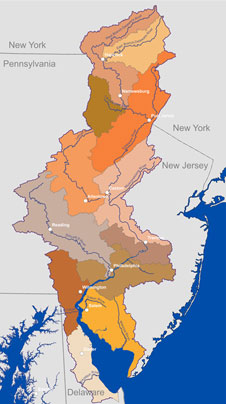Resources
States within the Delaware River Basin each have unique authorities and approaches to source water protection.
New Jersey: www.nj.gov/dep/swap/
The Source Water Assessment Program (SWAP) is administered by the Bureau of Safe Drinking Water, Division of Water Supply within the New Jersey Department of Environmental Protection. The information gained from source water assessments will encourage protection of water sources, provide information for watershed assessment and planning, and improve land use planning. The information developed from the SWAP will provide communities with the tools necessary to begin protecting their valuable drinking water source.
New York: www.health.state.ny.us/environmental/water/drinking/swap.htm
www.health.state.ny.us/environmental/water/drinking/wellhead/wellfact.htm
The New York State Department of Health (DOH) and the New York State Department of Environmental Conservation (DEC) both have roles in drinking water source protection. DOH is responsible for oversight of public water systems and for implementation of the Safe Drinking Water Act (SDWA). Since the late 1800’s, DOH has used the state statute authorizing watershed rules and regulations (WRR) to protect watersheds used by public water supplies. Specific WRR have been developed for numerous ground water and surface water sources across the state, particularly for watersheds used by large public water systems. Other programs administered by DOH and County Health Departments that protect drinking water sources include but are not limited to regulation of on-site septic systems and standards for water well construction. DOH also works in a supporting role in source water protection programs associated with other New York environmental quality programs implemented primarily by the DEC, including implementation of the Clean Water Act (CWA). These programs, including both point and non-point source pollution programs (e.g., waste discharges, solid and hazardous waste, bulk storage, pesticides, storm water, CAFO, spills etc.) include measures to protect both ground and surface waters. DEC classifies both surface water and ground water based on their best use and maintains water quality standards appropriate for each classification. The water quality standards were developed to protect public drinking water sources and wildlife. DOH and DEC work collaboratively and with all of the Federal and State Agencies involved in source protection.
Pennsylvania: www.dep.state.pa.us/dep/deputate/watermgt/wc/Subjects/SrceProt/SourceAssessment/default.htm
The Pennsylvania Department of Environmental Protection (DEP) conducts assessments of the susceptibility of public water system water sources to potential sources of contamination. These assessments have been done in accordance with Pennsylvania’s Source Water Assessment and Protection Program and the Safe Drinking Water Act. The previously existing Wellhead Protection Program is considered the cornerstone for the assessment of ground water sources serving public water systems. The purpose for conducting the assessments is to educate the public and promote the development of local, voluntary source water protection. DEP offers a variety of support for municipalities, water suppliers and the public to develop these local source water protection programs.
Delaware: www.wr.udel.edu/swaphome/index.html
The Delaware Department of Natural Resources and Environmental Control has the lead role in the development and implementation of the Delaware Source Water Assessment and Protection Program (SWAPP). The Delaware Division of Public Health and the Water Resources Agency, Institute for Public Administration at the University of Delaware, closely supports its work. A SWAPP Citizen and Technical Advisory Committee was formed at the start of this program in 1998 and is continuing to assist in developing and implementing Delaware’s SWAPP and ensures public involvement.
Webinars
October 9, 2014 Webinar
Delaware River Watershed Initiative: Overview on the NJ Highlands
Delaware River Watershed Initiative: Focus on the NJ Highlands
May 8, 2014 Webinar
USGS Delaware Water Census: USGS Delaware Water Census
USGS Urbanization Delaware River Watershed: USGS Urbanization Delaware River Watershed
October 24, 2013 Webinar
Schuylkill River Action Network (SAN): Funding Structure and Strategies
Schuylkill River National and State Heritage Area (SRHA): Schuylkill Restoration Fund
Philadelphia Water Department: Watershed Funding Strategies
August 15, 2013 Webinar
Click here for presentations
Reports and Newsletters
For a copy of power points from a knowledge transfer session “Freshwater Mussel Recovery Program” (September 14, 2014) presented by Dee Ross and Danielle Kreeger, Partnership for the Delaware Estuary, visit the following links:
Freshwater Mussel Volunteer Outreach 2014
Mussel Outreach 2014
For a copy of “Contaminants of Emerging Concern in the Tidal Delaware River Pilot Monitoring Survey, 2007-2009,” A. Ronald MacGillivray, Ph.D., DRBC, a power point presented during the webinar “Source Water Protection and Contaminants of Emerging Concern” (September 25, 2012, 10AM-11:30AM) visit the following link:
DRBSWC_CEC_MacGillivray-2012
For a copy of “Reducing Pharmaceuticals in Water: DEC’s Proactive Approach to Household, Institutional, and Manufacturing Discharges,” Scott Stoner, Chair, Pharmaceuticals Work Group, NYS Department of Environmental Conservation, a power point presented during the webinar “Source Water Protection and Contaminants of Emerging Concern” (September 25, 2012, 10AM-11:30AM) visit the following link:
Pharm-talk-for-Sept-25-2012.SJStoner
View a map of the Delaware River Basin created by the USGS:
ftp://ftpext.usgs.gov/pub/er/de/dover/DelRiverLandSatMap120.jpg
For a copy of the power point presentation on the recent webinar, “Economic Value of Source Water Protection in the Delaware Basin,” by GJ Kauffman, Director, Water Resources Agency, University of Delaware” please visit the following link:
http://www.delawarebasindrinkingwater.org/wp-content/uploads/2012/04/Economic-Value-of-Source-Water-Protection-in-the-Delaware-Basin-GJ-Kauffman.ppt
Read the summary report of the March 10, 2011 multi-site forum
Summary Report
Multimedia Resources
Watch a brief video summarizing the March 10, 2011 Forum:
http://www.epa.gov/region03/multimedia/playercontents/video/DRBF/DRBF2.html
Watch the recordings of Forum events around the basin from March 10, 2011:
http://www.delawarebasindrinkingwater.org/live-webcast/
Get to know the Delaware River Basin! Watch a Google Earth podcast and learn about the unique characteristics of this basin: http://www.epa.gov/region03/multimedia/playercontents/video/DRBT/DRBT2.html
In early March 2011, we visited Independence Square, Philadelphia, to hear some opinions about drinking water. Watch the 3 minute “Person On the Street Interviews” here:http://www.epa.gov/region03/multimedia/playercontents/video/MOS/MOS2.html
Forum Proceedings
Loch Sheldrake, NY
Sullivan County Community College
Stroudsburg, PA
Monroe County Public Center
Reading, PA
Reading Area Community College
Philadelphia, PA
WHYY Public Media Commons
Bordentown, NJ
Rutgers Eco Complex
Newark, DE
University of Delaware – Newark


